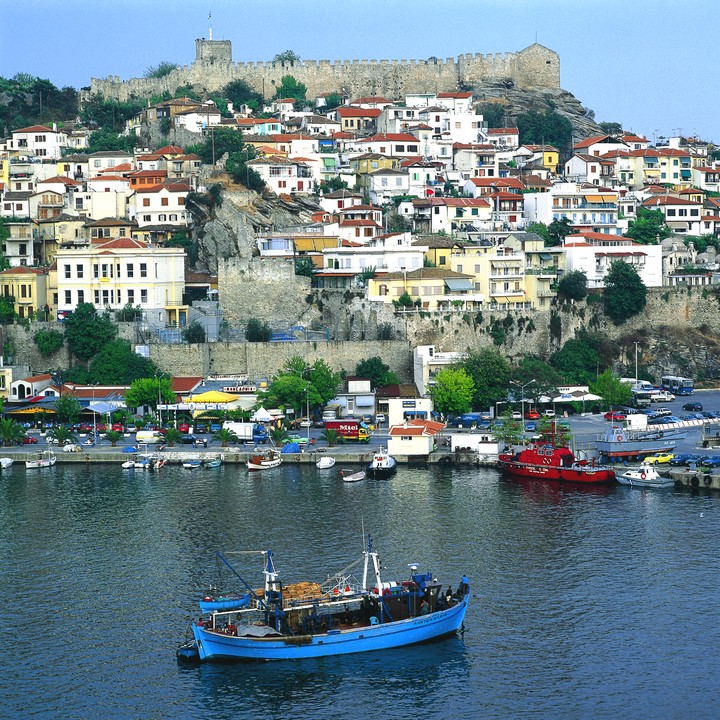In the traces of the ancient city Antissara (district of Kalamitsa today), built in a key position between the East and the West, Neapolis (city of Kavala nowadays) was found in the centre where two very important axes intersect: the vertical axe of Thassos – Kavala – Pangaion Hills and the horizontal one of Rome – Kavala – Istanbul. It once was a member of the First and Second Athenian Alliance, until the king of Macedonia Philip II conquered it. It then became an important haven (seaport) that linked the town of Philippi with the then known world. Later the Byzantines gave it the name Christoupolis, since it was the first European city to receive the teachings of Christianity from Apostle Paul. The city of Kavala was founded between 1520 and 1530.
One of the most characteristic elements of Kavala is the citadel. It stands on top of Panagia (Virgin Mary) peninsula, tied up in a harmonious total with the houses of the homonymous historical district that extend all around it in different levels.
It is very interesting to watch the course of the fortress in time.
Around 1530 the walls were repaired once again, at a larger extent and more assiduous. At this time, the exterior surrounding walls of the citadel were built, with the addition of which the fortress was extended considerably and increased its defensive puissance. More specifically, the exterior surrounding walls of the citadel must have been built during the years 1530 -1536, at the era where Suleiman the Magnificent decided to enforce its defence in several coastline positions (e.g. Thessaloniki – the White Tower). The exterior surrounding walls linked the citadel with the semi destroyed perimetrical walls of the peninsula and also fortified the lowest side of the hill, towards the harbour. The two entrance gates of the citadel are found here also: the First (in the place of an older Byzantine gate), is found at the end of today’s Kapsali street and is equipped with a «zematistra» (scalding spot – from where the defenders threw boiling oil at the enemies). The Second one (through which access is provided nowadays) is found at the end of Isidorou Street and was opened later on. A third gate exists in the partition wall of the two surrounding walls, next to the cylindrical tower. It was the initial entrance gate to the citadel and the only one between 1425 to 1530, until the construction of the exterior surrounding walls of the fortress was complete.
The fortification of Byzantine Christoupolis is visible at several points under the posterior repairs of the walls. The central circular tower of the Citadel is most probably of the Byzantine era – the existence of a fortress, that served as residence of the garrison commander and suitable for the projection of a last defence attempt, was a common characteristic of the Byzantine Citadels – the cistern, the two towers on the northern side, as well as the N.W. gate of the Citadel with the “zematistra”, a common defensive element of the Byzantine fortification constructions in the Greek area after the period of the Frankish Occupation. However, the original form of these constructions remains unknown as they were adapted to the later fortification construction. An important fortification construction of the beginning of the 14th century is also the “rampart near Christoupolis”, which is still saved in a monumental situation at the north of Kavala. According to information found in relevant sources, the wall is the work of the emperor Andronikos II Palaiologos in 1302, who was aiming at the reinforcement of the defensive line of the narrows the fortress of Christoupolis controlled. However, Christoupolis was not only a fortress in the Byzantine years. In 1154, the Arab geographer Idrisi describes it not only as a powerful fortress, but also as an important commercial port.
The archaeological excavations bring to light objects of everyday life, of the people living in the castle of Christoupolis, such as vessels with the characteristic enamel and the engraved decoration of the Byzantine years, or objects from their religious life, such as a cupreous cross shaped reliquary with an engraved representation of Christ Crucified. Last, while the Ottomans were spreading their conquests in Macedonia, and before they even occupy Istanbul, they successively conquered (from 1383 until 1391) the cities of Serres, Drama and Christoupolis which they totally destroyed in 1391. We get information on the destruction of the city from the codex 1391 of Mount Athos: “In this year the city of Christoupolis, the «Christonymous City», as it was called, was captured by the unfaithful nations and was demolished from its foundations and its inhabitants were scattered to various places and countries”.


